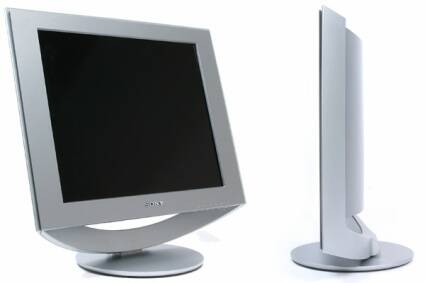LCD Comparison: 17" & 19" Under 20ms
Sony SDM-HS73P
Sony is proud to announce the release of its first computer monitor Black LCD. This technology in fact conceals two changes: backlighting is now ensured by just two neon lights at the base of the panel; above is a prism panel supposed to distribute the light uniformly; and more importantly, Sony has added a new film to the panel to make the blacks deeper.
However, this "revolutionary" technology is not really so revolutionary. We already came across it in a very similar sort of monitor by Neovo just two years ago. What we said about the X174 also applies to the HS73P. Better a picture than a long speech:
This is convenient for a woman to fix her makeup while watching a DVD on the same screen. Trouble is, if I can see myself that well, I won't be able to watch Matrix very well.
In fact, the screen becomes a mirror surface whenever it should display shade and the room is bright. This is less noticeable with light images. Unless you install the monitor in a room without light, this failing will affect a lot of uses: movies, games, graphic design, etc.
On the other hand, it will be perfect if you are working on office documents.
This flaw of picking up surrounding light sources is even more obvious when the monitor is run through calibration tests.
When the HS73P is tested with its default parameters, in normal conditions (daytime, closed curtains, etc), it is oblivious to black (it does display very dark colors, but that's not exactly black) and its color rendering is barely average. But if you put it in complete darkness, this monitor is one of the very few, with the Samsung 193P, to produce practically perfect black (DeltaE less than 3), true enough even for graphics professionals. By default and in complete darkness, the monitor reaches 215cd/m² for white and 0.43cd/m² (instead of 0.75cd/m² in a normally lit room). This is an actual contrast rate of 499:1, instead of 288:1 in normal lighting.
Get Tom's Hardware's best news and in-depth reviews, straight to your inbox.
215cd/m² might seem excessive. The buttons on the front are used to lower the lighting easily without touching the backlighting, brightness and contrast settings. If you opt for "LOW", brightness will be 121cd/m² and the colors still excellent... provided you are in an unlit room. In daylight, even softened by curtains, the intermediate and dark shades are definitely not so well rendered.
Those who want to use this monitor for games in spite of its mirror tendency, will like to hear that this is an AU Optronics panel. As is usual, all games, even the fastest, like Unreal Tournament, are perfectly playable and are hardly affected by afterglow.
The last criticism we have to make regarding the HS73P is that its ergonomic features could do with an overhaul. This is one of the first monitors to get the minimum rating here. The power supply is external, it is not height-adjustable, the viewing angles are narrow, there is just an analog input, no DVI, no other video input, no USB hub, no pivot function and no way to hang it on the wall.
| Ergonomics | - |
| Colors | **** |
| Interpolation | ** |
| Games | *** |
| Movies | * |

